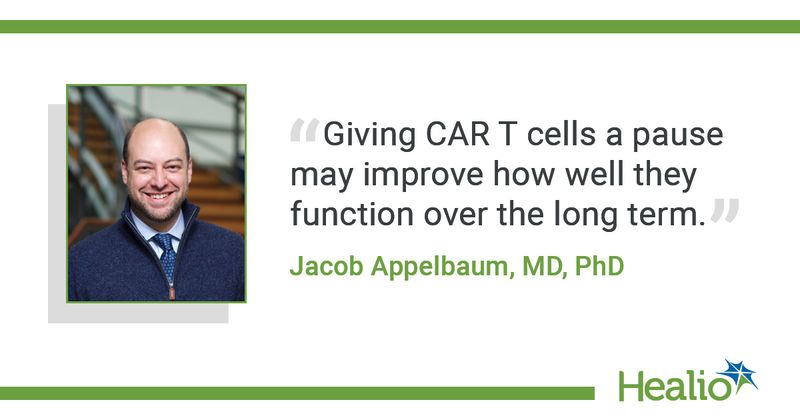Novel leukemia treatment signals ‘new era in CAR T-cell therapy’
Key takeaways:
- Treatment with a novel CAR T-cell therapy at the lowest dose level resulted in transient elimination of acute myeloid leukemia blasts for one patient.
- Researchers observed no dose-limiting toxicities.
An investigational chimeric antigen receptor T-cell therapy demonstrated successful expansion and antitumor targeting among younger patients with advanced acute myeloid leukemia, results of the phase 1 PLAT-08 trial showed.
The findings — presented at American Society for Gene & Cell Therapy Annual Meeting — demonstrated the feasibility and safety of pharmacologically controlled CAR T cells once infused into patients, investigators suggested.

Early results from the first-in-human trial showed elimination of AML blasts in one patient who received the study’s lowest planned dose level.
“This opens a new era in CAR T-cell therapy,” Jacob Appelbaum, MD, PhD, physician-scientist at Fred Hutchinson Cancer Center and acting instructor in the division of hematology at University of Washington School of Medicine, told Healio. “This is a major advance and, to my knowledge, is the first controllable CAR-T with an on/off switch to be evaluated in humans.”
Background
Patients diagnosed with AML who have detectable levels of leukemia after their initial therapy tend to have poor outcomes. This is true even for those who go on to receive hematopoietic stem cell transplantation, Appelbaum said.
“The existing tools don’t solve the problem, and AML is the most common leukemia among adults and second most common among children,” he said. “Most of the people diagnosed with AML will die of their disease, so there’s a real unmet clinical need.”
Appelbaum and colleagues are part of a group at Seattle Children’s Hospital that — through a commercial collaboration with 2seventy bio — is developing SC-DARIC33, an investigational, pharmacologically controlled, CD33-targeted CAR T-cell therapy. The therapy is based on the company’s proprietary dimerizing agent regulated immunoreceptor complex (DARIC) T-cell platform.
DARIC T cells are designed to activate in the presence of adequate levels of rapamycin and the target antigen, giving the CAR T cells an on/off functionality that can be controlled by providers.
Existing CD19-directed CAR T cells eliminate B cells in circulation for a period of time but patients can survive this risk to the immune system through supplementation and other mitigation measures, Appelbaum said.
However, the same is not true for CAR products that target CD33. The elimination of these cells from the circulation causes patients to become neutropenic and puts them at an unacceptably high risk of infection, Appelbaum said.
Having a CAR-T that can be activated at the direction of clinicians could offer both safety and efficacy benefits, Appelbaum said.
“There has been a lot of previous research showing that continuously exposing CAR T cells to antigens causes them to stop working and become exhausted,” he said. “Giving CAR T cells a pause may improve how well they function over the long term.”
Methodology
PLAT-08 is a first-in-human phase 1 dose-escalation study designed to evaluate the safety and feasibility of SC-DARIC33 for children and young adults with relapsed or refractory CD33-positive AML.
The study included three patients aged younger than 30 years with early relapse disease (less than 6 months), first relapse refractory to reinduction therapy, or second or more disease relapse.
Study participants underwent preconditioning lymphodepletion followed by a single infusion of 1 × 106 SC-DARIC33 CAR T cells/kg.
Additional dose levels of 5 × 106 CAR T cells/kg and 1 × 107 CAR T cells/kg are planned for subsequent enrollees.
Determining the maximum tolerated and biologically effective dose served as the trial’s primary objective. Secondary objectives included treatment efficacy, engraftment, expansion and persistence.
Key findings
No dose-limiting toxicities occurred by data cutoff. All infusions had been well tolerated, and no additional safety issues had been observed, Appelbaum said.
Investigators observed expansion of SC-DARIC33 that occurred within the rapamycin activation goal range in two of the three patients eligible for analysis.
One patient showed evidence of CAR T-cell activation at the disease site. The other patient experienced CAR T-cell expansion within the blood accompanied by transient elimination of AML blasts.
Improved rapamycin targeting within the goal range accompanied expansion of SC-DARIC33 within the blood, researchers noted.
Clinical implications
Results from the first few patients demonstrate the feasibility of the DARIC platform and clinicians’ ability to adjust the levels of rapamycin to achieve CAR T-cell activation in patients, Appelbaum said.
The first dose level explored in the PLAT-08 trial was low to ensure safety, he said. The trial continues to enroll patients and SC-DARIC33 CAR T cells have the potential to provide clinically meaningful treatment benefit when given at higher dose levels, he added.
“CAR T-cell therapy is extremely powerful in treating leukemias,” Appelbaum said. “We already know that T cells have the potential to control AML over the long term. It’s just a matter of finding the right targets, the right cell product and the right clinical situation.”

